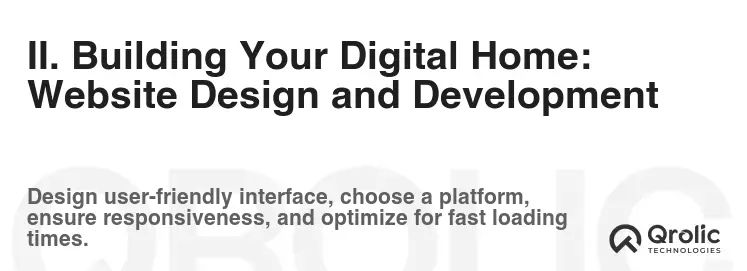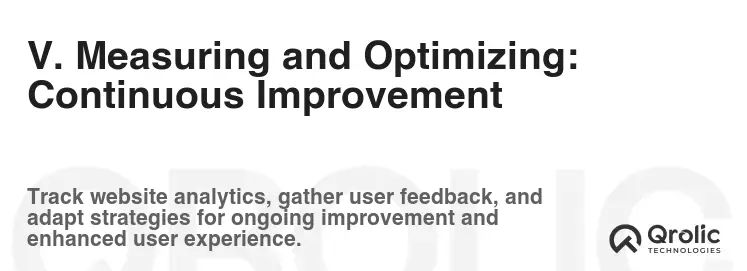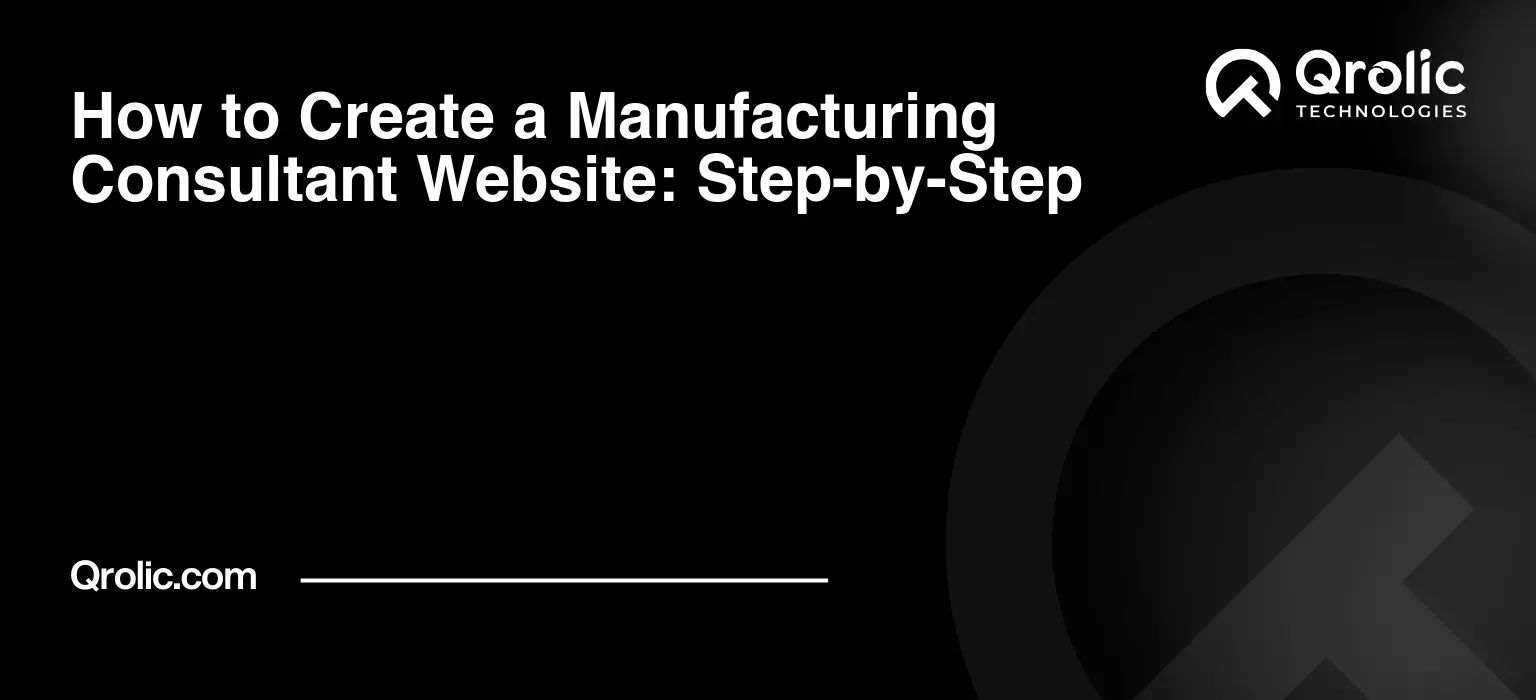Quick Summary:
- Plan your niche, goals, and website keywords.
- Build a professional, mobile-friendly website with essential pages.
- Create valuable, SEO-optimized content with engaging visuals.
- Drive traffic using SEO, content, social, and email marketing.
Table of Contents
- I. Laying the Foundation: Planning Your Manufacturing Consultant Website
- A. Defining Your Niche and Target Audience: The Core of Your Success
- B. Competitive Analysis: Understanding the Landscape
- C. Defining Your Website’s Purpose and Goals: Charting Your Course
- D. Keyword Research: Speaking the Language of Your Customers
- II. Building Your Digital Home: Website Design and Development
- A. Choosing a Domain Name and Hosting Provider: Your Online Address
- B. Selecting a Website Platform: Your Digital Canvas
- C. Choosing a Theme: Visualizing Your Brand
- D. Essential Pages: Guiding Your Visitors
- III. Crafting Compelling Content: Engaging Your Audience
- A. Writing High-Quality, SEO-Optimized Content: Attracting the Right Visitors
- B. Creating Engaging Visuals: Capturing Attention
- C. Optimizing for Mobile: Reaching the Modern User
- IV. Driving Traffic and Generating Leads: Marketing Your Expertise
- A. Search Engine Optimization (SEO): Making Yourself Discoverable
- B. Content Marketing: Building Authority and Trust
- C. Social Media Marketing: Connecting with Your Audience
- D. Email Marketing: Nurturing Leads and Building Relationships
- E. Paid Advertising: Reaching a Wider Audience
- V. Measuring and Optimizing: Continuous Improvement
- A. Website Analytics: Understanding Your Audience’s Behavior
- B. A/B Testing: Optimizing for Conversions
- C. Staying Up-to-Date: Adapting to Change
- VI. Qrolic Technologies: Your Partner in Digital Transformation
I. Laying the Foundation: Planning Your Manufacturing Consultant Website

A. Defining Your Niche and Target Audience: The Core of Your Success
Before even thinking about website design, you must pinpoint who you’re trying to reach and what specific problems you solve for them. This isn’t just about saying “I help manufacturers.” It’s about carving out a specific niche.
-
Why is Niche Definition Crucial? Imagine trying to sell refrigerators to Eskimos. Futile, right? A well-defined niche focuses your marketing efforts, allowing you to speak directly to the needs of a specific group of manufacturers, improving your chances of conversion.
-
How to Identify Your Ideal Client:
- Industry Expertise: What industries do you have the most experience in? Automotive? Aerospace? Food processing? Identify your areas of strength.
- Company Size: Do you specialize in helping small, family-owned businesses, or large multinational corporations? Their needs and budgets are vastly different.
- Specific Problems Solved: Are you an expert in lean manufacturing, supply chain optimization, industrial design, or quality control? Define the specific challenges you address.
- Geographic Focus: Do you primarily serve clients in your local area, a specific region, or internationally?
-
Examples of Niche Specializations:
- “Lean Manufacturing Consultant for Automotive Suppliers in the Midwest.”
- “Supply Chain Optimization Expert for Food Processing Companies in Europe.”
- “Industrial Design Consultant for Medical Device Manufacturers Globally.”
- “Quality Control Specialist for Aerospace Component Manufacturers in North America”
-
Benefits of a Niche Focus:
- Higher Conversion Rates: Targeting a specific audience with tailored messaging leads to more qualified leads.
- Reduced Competition: By specializing, you avoid competing with generalist consultants.
- Increased Authority: Expertise in a specific area builds credibility and trust.
- Improved SEO: Niche keywords are easier to rank for.
B. Competitive Analysis: Understanding the Landscape
Knowing what your competitors are doing is crucial for differentiating yourself. This isn’t about copying them; it’s about learning from their successes and identifying opportunities they’ve missed.
-
Why Conduct Competitive Analysis? Think of it as reconnaissance before a battle. You need to understand your enemy’s strengths and weaknesses to formulate a winning strategy.
-
How to Analyze Your Competitors’ Websites:
- Identify Your Top Competitors: Use Google and industry directories to find consultants targeting your niche.
- Analyze Their Website Design: Is it modern and professional? Is it easy to navigate?
- Evaluate Their Content: What topics do they cover? How in-depth is their content? Is it engaging?
- Assess Their SEO: What keywords are they targeting? How well do they rank in search results?
- Examine Their Value Proposition: What unique benefits do they offer? How do they differentiate themselves?
- Observe Their Calls to Action: How do they encourage visitors to contact them?
-
Key Questions to Answer:
- What are their strengths and weaknesses?
- What keywords are they targeting?
- What types of content are they creating?
- What is their pricing strategy?
- What is their target audience?
- What are they doing well, and what could they improve?
-
Tools for Competitive Analysis:
- SEMrush: Provides detailed insights into competitor’s SEO strategies.
- Ahrefs: Similar to SEMrush, offering comprehensive SEO analysis tools.
- Moz: Offers a suite of SEO tools, including keyword research and rank tracking.
- BuiltWith: Identifies the technologies used on a website.
C. Defining Your Website’s Purpose and Goals: Charting Your Course
What do you want your website to achieve? This goes beyond simply having an online presence. You need specific, measurable, achievable, relevant, and time-bound (SMART) goals.
-
Why is Goal Setting Important? Without clear goals, you’re sailing without a compass. You’ll be wasting time and resources without a clear direction.
-
Examples of Website Goals:
- Generate Leads: Collect contact information from potential clients through forms, email sign-ups, or gated content.
- Increase Brand Awareness: Establish yourself as a thought leader in your industry through informative blog posts, case studies, and white papers.
- Drive Sales: Offer online consultations or sell digital products.
- Improve Customer Service: Provide a knowledge base, FAQs, and contact information for existing clients.
- Recruit Talent: Attract qualified candidates to join your consulting team.
-
Specific Examples of SMART Goals:
- “Increase the number of leads generated through the website by 20% in the next quarter.”
- “Improve website traffic by 15% in the next month by optimizing for relevant keywords.”
- “Increase the conversion rate of website visitors to leads by 5% within 6 months by improving the call-to-action.”
- “Achieve a first-page ranking on Google for the keyword ‘lean manufacturing consultant’ within 12 months.”
D. Keyword Research: Speaking the Language of Your Customers
Understanding the language your target audience uses when searching for manufacturing consultants is crucial for SEO success. This involves identifying relevant keywords and phrases that you can incorporate into your website content.
-
Why is Keyword Research Essential? It’s the key to attracting the right visitors to your website. If you don’t know what your target audience is searching for, you won’t be able to reach them.
-
Types of Keywords:
- Head Keywords: Broad terms with high search volume (e.g., “manufacturing consultant”).
- Long-Tail Keywords: More specific phrases with lower search volume but higher conversion rates (e.g., “lean manufacturing consultant for automotive suppliers in Detroit”).
-
How to Conduct Keyword Research:
- Brainstorming: Start by listing all the possible keywords and phrases that your target audience might use.
- Competitor Analysis: Analyze your competitors’ websites to see what keywords they’re targeting.
- Keyword Research Tools: Use tools like Google Keyword Planner, SEMrush, Ahrefs, and Moz Keyword Explorer to identify high-volume, low-competition keywords.
- Customer Interviews: Talk to your existing clients to understand the language they use when describing their needs.
- Industry Forums and Online Communities: Monitor discussions in industry forums and online communities to identify trending topics and relevant keywords.
-
Examples of Relevant Keywords:
- Manufacturing consultant
- Lean manufacturing
- Supply chain optimization
- Industrial design
- Quality control
- Process improvement
- Operational excellence
- Manufacturing engineering
- Six Sigma
- Industrial automation
- Manufacturing consulting services
- [Your Niche] manufacturing consultant
-
Key Metrics to Consider:
- Search Volume: The number of times a keyword is searched for each month.
- Keyword Difficulty: A measure of how difficult it is to rank for a particular keyword.
- Cost-Per-Click (CPC): The amount you would have to pay for each click if you were to advertise on Google using that keyword.
- Relevance: How relevant the keyword is to your business and your target audience.
II. Building Your Digital Home: Website Design and Development

A. Choosing a Domain Name and Hosting Provider: Your Online Address
Your domain name is your online identity. Choose one that’s memorable, relevant, and easy to spell. Your hosting provider is the foundation upon which your website sits; choose one that’s reliable and scalable.
-
Why is Domain Name and Hosting Important? They’re the foundation of your online presence. A bad domain name can make you look unprofessional, and unreliable hosting can make your website inaccessible.
-
Domain Name Best Practices:
- Keep it Short and Memorable: Easier to remember and type.
- Use Keywords (If Possible): Incorporate relevant keywords if it sounds natural.
- Choose the Right Extension: .com is generally preferred, but .net or .org can work in some cases.
- Check Availability: Ensure the domain name is available and not already taken.
- Avoid Hyphens and Numbers: Can be confusing and harder to remember.
-
Hosting Provider Considerations:
- Reliability: Look for providers with high uptime guarantees (e.g., 99.9%).
- Speed: Choose a provider with fast servers and content delivery networks (CDNs).
- Security: Ensure the provider offers security features like SSL certificates and firewalls.
- Scalability: Choose a provider that can accommodate your website’s growth.
- Customer Support: Look for providers with responsive and helpful customer support.
- Price: Compare prices from different providers, but don’t sacrifice quality for cost.
-
Popular Hosting Providers:
- Bluehost: A popular and affordable option, especially for wordpress websites.
- SiteGround: Known for its speed, security, and excellent customer support.
- WP Engine: A managed WordPress hosting provider, optimized for performance and security.
- HostGator: Another popular and affordable option, offering a variety of hosting plans.
- AWS (Amazon Web Services): A more advanced option, offering a wide range of cloud computing services.
B. Selecting a Website Platform: Your Digital Canvas
Choosing the right platform is crucial for building a website that’s both functional and easy to manage. WordPress is a popular choice, but other options exist.
-
Why is Platform Selection Important? It determines how easy it is to create, manage, and update your website. A platform that’s too complex can be frustrating, while one that’s too simple might not offer the features you need.
-
Popular Website Platforms:
- WordPress: The most popular platform, offering a vast library of themes and plugins.
- Wix: A drag-and-drop website builder, ideal for beginners.
- Squarespace: Another drag-and-drop builder, known for its sleek design templates.
- Joomla: A more advanced content management system (CMS), offering greater flexibility than WordPress.
- Drupal: Another advanced CMS, often used for complex websites with high security requirements.
-
Why WordPress is Often Recommended:
- Flexibility: Thousands of themes and plugins allow you to customize your website to meet your specific needs.
- SEO-Friendly: WordPress is designed to be search engine friendly, making it easier to rank in search results.
- Easy to Use: WordPress is relatively easy to learn, even for beginners.
- Large Community: A large community of users and developers provides ample support and resources.
- Cost-Effective: WordPress is free to use, and many themes and plugins are also free.
C. Choosing a Theme: Visualizing Your Brand
Your website’s theme is its visual identity. Choose a theme that’s professional, modern, and reflects your brand. It should also be responsive, meaning it looks good on all devices.
-
Why is Theme Selection Important? It’s the first impression your website makes on visitors. A well-designed theme can build trust and credibility, while a poorly designed theme can turn visitors away.
-
Theme Considerations:
- Professional Design: Choose a theme that looks professional and modern.
- Responsiveness: Ensure the theme is responsive and looks good on all devices (desktops, laptops, tablets, and smartphones).
- Customizability: Choose a theme that’s easy to customize to match your brand.
- SEO-Friendliness: Ensure the theme is optimized for search engines.
- Speed: Choose a theme that’s lightweight and loads quickly.
- Compatibility: Ensure the theme is compatible with the plugins you plan to use.
-
Where to Find Themes:
- WordPress.org Theme Directory: A vast library of free themes.
- ThemeForest: A popular marketplace for premium themes.
- Elegant Themes: Offers a subscription-based access to a library of themes and plugins.
D. Essential Pages: Guiding Your Visitors
Every manufacturing consultant website needs certain core pages to inform visitors and guide them towards becoming clients.
-
Home Page: Your website’s front door. Briefly introduce your services, highlight your expertise, and provide clear calls to action. Focus on the benefits you offer. Example: “Increase efficiency and reduce costs with our proven lean manufacturing strategies.”
-
About Us: Tell your story. Share your background, experience, and qualifications. Build trust by showcasing your team and your values. Include testimonials or case studies to demonstrate your expertise.
-
Services: Clearly outline the specific services you offer, such as lean manufacturing, supply chain optimization, industrial design, or quality control. Explain the process and the benefits of each service. Provide examples of past projects.
-
Case Studies: Showcase your successes. Detail specific projects you’ve worked on, the challenges you faced, and the results you achieved. Quantify your impact whenever possible (e.g., “Reduced production costs by 15%”).
-
Blog: Establish yourself as a thought leader by sharing your insights on industry trends, best practices, and emerging technologies. Optimize your blog posts for relevant keywords.
-
Contact Us: Make it easy for potential clients to reach you. Include a contact form, email address, phone number, and social media links. Consider adding a map to your physical location (if applicable).
-
Testimonials: Social proof is powerful. Display testimonials from satisfied clients to build trust and credibility. Ask clients for permission to use their testimonials on your website.
-
Privacy Policy & Terms of Service: Ensure compliance with legal requirements and protect your business.
III. Crafting Compelling Content: Engaging Your Audience

A. Writing High-Quality, SEO-Optimized Content: Attracting the Right Visitors
Content is king. It’s what attracts visitors to your website and convinces them to become clients. Your content should be informative, engaging, and optimized for relevant keywords.
-
Why is High-Quality Content Important? It’s the foundation of your online presence. It attracts visitors, builds trust, and converts leads.
-
Content Best Practices:
- Focus on Your Target Audience: Write content that addresses their specific needs and interests.
- Use Clear and Concise Language: Avoid jargon and technical terms that your audience might not understand.
- Provide Value: Offer informative and actionable content that solves your audience’s problems.
- Optimize for Keywords: Incorporate relevant keywords into your content naturally.
- Use Headings and Subheadings: Break up your content into easily digestible chunks.
- Use Images and Videos: Visuals can make your content more engaging.
- Proofread Carefully: Ensure your content is free of errors.
-
Types of Content to Create:
- Blog Posts: Share your insights on industry trends, best practices, and emerging technologies.
- Case Studies: Showcase your successes and demonstrate the value of your services.
- White Papers: Provide in-depth information on specific topics.
- Ebooks: Offer comprehensive guides on complex subjects.
- Infographics: Present data and information in a visually appealing format.
- Videos: Create video tutorials, interviews, and presentations.
- Podcasts: Share your insights through audio content.
-
SEO Content Optimization:
- Keyword Research: Identify the keywords your target audience is searching for.
- On-Page Optimization: Optimize your website’s content, including title tags, meta descriptions, headings, and body text, for relevant keywords.
- Off-Page Optimization: Build backlinks from other reputable websites to increase your website’s authority.
B. Creating Engaging Visuals: Capturing Attention
Visuals can make your website more appealing and engaging. Use high-quality images, videos, and graphics to capture your audience’s attention.
-
Why are Visuals Important? They can break up text, illustrate concepts, and create a more memorable experience for visitors.
-
Types of Visuals to Use:
- High-Quality Images: Use professional-looking images that are relevant to your content.
- Videos: Create video tutorials, interviews, and presentations.
- Infographics: Present data and information in a visually appealing format.
- Charts and Graphs: Visualize data and trends.
- Illustrations: Create custom illustrations to enhance your brand.
-
Where to Find Visuals:
- Stock Photo Websites: shutterstock, iStockphoto, Unsplash, Pexels.
- Graphic Design Software: Adobe Photoshop, Adobe Illustrator, Canva.
- Video Editing Software: Adobe Premiere Pro, Final Cut Pro, iMovie.
C. Optimizing for Mobile: Reaching the Modern User
More and more people are accessing the internet on their mobile devices. Make sure your website is responsive and looks good on all devices.
-
Why is Mobile Optimization Important? It’s essential for providing a good user experience and ranking well in search results. Google prioritizes mobile-friendly websites.
-
Mobile Optimization Best Practices:
- Use a Responsive Theme: Ensure your theme is responsive and adapts to different screen sizes.
- Optimize Images: Compress images to reduce file size and improve loading speed.
- Use Mobile-Friendly Navigation: Make it easy for users to navigate your website on their mobile devices.
- Use a Large Font Size: Make it easy for users to read your content on their mobile devices.
- Avoid Flash: Flash is not supported on most mobile devices.
- Test Your Website on Different Devices: Ensure your website looks good on a variety of mobile devices.
IV. Driving Traffic and Generating Leads: Marketing Your Expertise

A. Search Engine Optimization (SEO): Making Yourself Discoverable
SEO is the process of optimizing your website to rank higher in search results. This involves keyword research, on-page optimization, and off-page optimization.
-
Why is SEO Important? It’s the most effective way to drive organic traffic to your website. Organic traffic is free and highly targeted.
-
SEO Best Practices:
- Keyword Research: Identify the keywords your target audience is searching for.
- On-Page Optimization: Optimize your website’s content, including title tags, meta descriptions, headings, and body text, for relevant keywords.
- Off-Page Optimization: Build backlinks from other reputable websites to increase your website’s authority.
- Technical SEO: Ensure your website is technically sound and easy for search engines to crawl.
- Local SEO: Optimize your website for local search results.
-
Key SEO Metrics:
- Organic Traffic: The number of visitors who come to your website from search engines.
- Keyword Rankings: The position of your website in search results for specific keywords.
- Backlinks: The number of links from other websites to your website.
- Domain Authority: A measure of your website’s authority and trustworthiness.
B. Content Marketing: Building Authority and Trust
Content marketing is the process of creating and distributing valuable, relevant, and consistent content to attract and engage a target audience.
-
Why is Content Marketing Important? It’s a long-term strategy for building authority, trust, and generating leads.
-
Content Marketing Best Practices:
- Create High-Quality Content: Offer informative and actionable content that solves your audience’s problems.
- Be Consistent: Publish new content regularly.
- Promote Your Content: Share your content on social media, email, and other channels.
- Engage with Your Audience: Respond to comments and questions.
- Track Your Results: Measure the effectiveness of your content marketing efforts.
C. Social Media Marketing: Connecting with Your Audience
Social media is a powerful tool for connecting with your target audience, building brand awareness, and generating leads.
-
Why is Social Media Marketing Important? It allows you to reach a large audience, build relationships, and drive traffic to your website.
-
Social Media Marketing Best Practices:
- Choose the Right Platforms: Focus on the platforms where your target audience is most active.
- Create Engaging Content: Share informative, entertaining, and visually appealing content.
- Be Consistent: Post regularly.
- Engage with Your Audience: Respond to comments and questions.
- Use Hashtags: Use relevant hashtags to increase the visibility of your posts.
- Run Contests and Giveaways: Generate excitement and engagement.
- Track Your Results: Measure the effectiveness of your social media marketing efforts.
D. Email Marketing: Nurturing Leads and Building Relationships
Email marketing is a cost-effective way to nurture leads, build relationships, and drive sales.
-
Why is Email Marketing Important? It allows you to communicate directly with your target audience, build trust, and promote your services.
-
Email Marketing Best Practices:
- Build an Email List: Collect email addresses from your website, social media, and other channels.
- Segment Your List: Divide your list into smaller groups based on their interests and demographics.
- Create Compelling Email Content: Offer valuable information, special offers, and personalized messages.
- Use a Professional Email Marketing Platform: Use a platform like Mailchimp or Constant Contact to manage your email campaigns.
- Test Your Emails: Test different subject lines, content, and calls to action to optimize your results.
- Track Your Results: Measure the effectiveness of your email marketing efforts.
E. Paid Advertising: Reaching a Wider Audience
Paid advertising, such as Google Ads and social media advertising, can help you reach a wider audience and generate leads quickly.
-
Why is Paid Advertising Important? It allows you to target specific demographics and interests, and to reach people who are actively searching for your services.
-
Paid Advertising Best Practices:
- Define Your Target Audience: Identify the demographics, interests, and behaviors of your ideal clients.
- Set a Budget: Determine how much you’re willing to spend on advertising.
- Choose the Right Platforms: Focus on the platforms where your target audience is most active.
- Create Compelling Ad Copy: Write persuasive ad copy that highlights the benefits of your services.
- Use Relevant Keywords: Target relevant keywords to reach people who are actively searching for your services.
- Track Your Results: Measure the effectiveness of your advertising campaigns.
V. Measuring and Optimizing: Continuous Improvement

A. Website Analytics: Understanding Your Audience’s Behavior
Website analytics tools, such as Google Analytics, provide valuable insights into how visitors are using your website.
-
Why is Website Analytics Important? It allows you to track your website’s performance, understand your audience’s behavior, and identify areas for improvement.
-
Key Website Analytics Metrics:
- Traffic: The number of visitors to your website.
- Bounce Rate: The percentage of visitors who leave your website after viewing only one page.
- Time on Site: The average amount of time visitors spend on your website.
- Conversion Rate: The percentage of visitors who complete a desired action, such as filling out a form or making a purchase.
- Top Pages: The most popular pages on your website.
- Traffic Sources: The sources of traffic to your website (e.g., organic search, social media, email).
B. A/B Testing: Optimizing for Conversions
A/B testing involves testing different versions of your website’s elements, such as headlines, images, and calls to action, to see which performs better.
-
Why is A/B Testing Important? It allows you to optimize your website for conversions and improve your results.
-
A/B Testing Best Practices:
- Test One Element at a Time: Focus on testing one element at a time to isolate the impact of each change.
- Use a Control Group: Compare the results of the test group to a control group that sees the original version of the element.
- Run Tests for a Sufficient Period: Run tests for a sufficient period to gather enough data to draw meaningful conclusions.
- Track Your Results: Measure the effectiveness of each test.
C. Staying Up-to-Date: Adapting to Change
The digital landscape is constantly evolving. It’s important to stay up-to-date on the latest trends and technologies.
-
Why is Staying Up-to-Date Important? It allows you to adapt to change, stay ahead of the competition, and continue to improve your results.
-
How to Stay Up-to-Date:
- Read Industry Blogs and Publications: Follow industry blogs and publications to stay informed about the latest trends and best practices.
- Attend Conferences and Webinars: Attend conferences and webinars to learn from industry experts.
- Network with Other Professionals: Network with other professionals in your industry to share ideas and learn from each other.
- Experiment with New Technologies: Experiment with new technologies to see how they can benefit your business.
VI. Qrolic Technologies: Your Partner in Digital Transformation

As a manufacturing consultant, you understand the importance of efficiency, innovation, and staying ahead of the curve. Qrolic Technologies (https://qrolic.com/) can be your strategic partner in achieving digital transformation, not just for your clients, but also for your own consulting business.
How Qrolic Technologies Can Help Your Manufacturing Consulting Business:
-
Website Development and Optimization: Qrolic Technologies can build or revamp your manufacturing consultant website to be SEO-friendly, mobile-responsive, and conversion-optimized, ensuring it accurately reflects your expertise and attracts your target audience. Their industrial design capabilities ensure a visually appealing and user-friendly experience.
-
Custom Software Development: Enhance your consulting services with custom software solutions tailored to specific client needs. Qrolic Technologies can develop tools for data analysis, process simulation, or predictive maintenance, giving you a competitive edge.
-
Cloud Solutions: Leverage the power of the cloud with Qrolic Technologies’ expertise in cloud migration, infrastructure management, and application development. This enables you to offer scalable and cost-effective solutions to your clients.
-
Data Analytics and Business Intelligence: Provide data-driven insights to your clients with Qrolic Technologies’ data analytics services. They can help you analyze manufacturing data, identify trends, and make informed decisions to improve efficiency and profitability.
-
Cybersecurity Solutions: Protect your clients’ sensitive data and systems with Qrolic Technologies’ cybersecurity solutions. They can assess vulnerabilities, implement security measures, and provide ongoing monitoring to ensure data security.
-
AI and Machine Learning: Integrate AI and machine learning into your consulting services to offer cutting-edge solutions. Qrolic Technologies can develop AI-powered tools for predictive maintenance, quality control, and process optimization.
Benefits of Partnering with Qrolic Technologies:
- Enhanced Service Offerings: Expand your service offerings with innovative digital solutions.
- Increased Client Value: Provide more value to your clients by helping them embrace digital transformation.
- Competitive Advantage: Differentiate yourself from other manufacturing consultants with cutting-edge technology.
- Improved Efficiency: Streamline your own business processes with digital tools and automation.
- Increased Revenue: Generate new revenue streams by offering digital services.
By partnering with Qrolic Technologies, you can stay ahead of the curve and provide your clients with the innovative solutions they need to succeed in today’s digital world. Leverage their expertise to build a stronger, more successful manufacturing consulting business.









